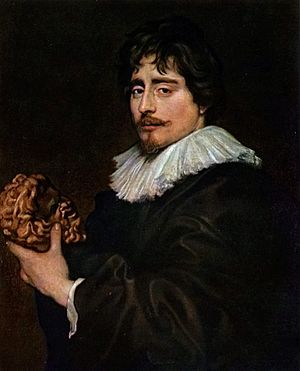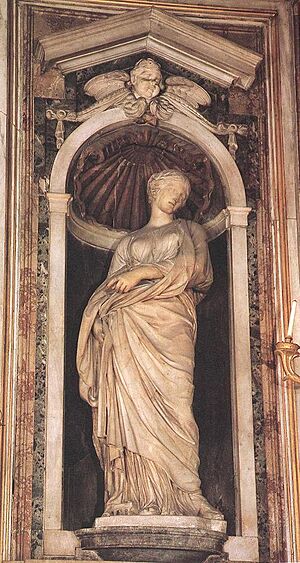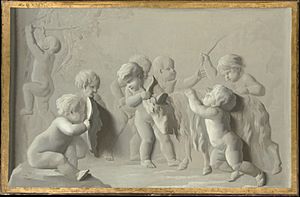François Duquesnoy facts for kids
Quick facts for kids
François Duquesnoy
|
|
|---|---|

Portrait by Anthony van Dyck
|
|
| Born | 12 January 1597 |
| Died | 19 July 1643 (aged 46) |
| Nationality | Flemish |
| Known for | Sculpture |
|
Notable work
|
Saint Susanna, Saint Andrew, Tomb of Ferdinand van den Eynde |
| Movement | Baroque |
François Duquesnoy (born January 12, 1597 – died July 18, 1643) was a famous Flemish sculptor. He worked mostly in Rome, Italy, during the Baroque period. His sculptures often showed perfect, ideal figures. People sometimes compared his calm style to the more dramatic works of Bernini. Duquesnoy's art was also very similar to the sculptures of Algardi.
Contents
François Duquesnoy: A Famous Sculptor
François Duquesnoy was born in Brussels, which is now in Belgium. Because he came from Flanders, Italians called him Il Fiammingo, meaning "the Fleming." The French called him François Flamand.
Early Life and Training
Duquesnoy's father, Jerôme Duquesnoy the Elder, was also a sculptor. He created the famous Manneken Pis fountain in Brussels. His father was the official sculptor for Archduchess Isabella and Archduke Albert, who ruled the Low Countries. François's brother, Jerôme Duquesnoy the younger, was also a sculptor.
François's early work in Brussels caught the attention of the Archduke. The Archduke then helped him go to Rome to study. Duquesnoy spent his entire career in Rome.
Studying Ancient Art in Rome
When Duquesnoy arrived in Rome in 1618, he carefully studied ancient sculptures. He even climbed on the Equestrian Statue of Marcus Aurelius to learn how it was made. He also visited the ancient shrine of Diana at Lake Nemi.
In 1624, Nicolas Poussin, a painter with a similar calm and classical style, came to Rome. The two artists lived together. They were both supported by Cassiano dal Pozzo, a wealthy art lover. They aimed to create ideal figures that were different from the dramatic Baroque style of Bernini.
Critics like Giovanni Pietro Bellori praised Duquesnoy's art. Bellori wrote in 1672 that Duquesnoy's work brought back the quality of ancient Roman sculpture. He said that with his Santa Susanna statue, Duquesnoy showed modern sculptors how to create clothed figures. Bellori believed Duquesnoy was even better than the best ancient sculptors.
Working with Bernini
Duquesnoy created small sculptures of angels (called putti) for the Villa Doria Pamphili. Even though their styles were different, Duquesnoy worked with Bernini. He helped design the angels holding garlands for the baldacchino in St. Peter's Basilica. This work was done between 1624 and 1633. The four angels were entirely Duquesnoy's work. This project helped him get more jobs in the future.
Famous Sculptures by Duquesnoy
The Statue of Santa Susanna
Duquesnoy's Santa Susanna (1629) is a classic example of his style. The statue shows the saint looking both modest and revealing under her marble clothes. Bellori noted that "the pure volume of the members is visible." This statue was one of four sculptures of virgin martyrs made for the church of Santa Maria di Loreto in Rome.
People have admired the smooth surfaces and the gentle, sweet feeling of this statue. Her empty gaze gives her a spiritual look. The sculpture was not very well known until the 1700s. Then, a marble copy was sent to Paris in 1739. After that, Duquesnoy's Susanna became one of the most admired modern sculptures.
The Statue of Saint Andrew
The larger-than-life marble statue of Saint Andrew (1629–33) is more dramatic. It was started shortly after he finished the Santa Bibiana. This statue is one of four large statues that surround the baldacchino in the transept of St. Peter's Basilica. Each statue is linked to important holy items in the basilica. The other three statues are Bernini's Saint Longinus, Mochi's Saint Veronica, and Bolgi's St Helena.
It's interesting to compare Duquesnoy's Andrew with Bernini's Longinus. In Andrew, the clothes hang down naturally. In Longinus, the clothes look stiff and dramatic. Andrew leans on the X-shaped cross where he was martyred. Longinus dramatically throws his arms out, showing divine power. Both statues use diagonal lines, but Duquesnoy's is more calm than Bernini's or Mochi's.
Other Notable Works
Later Career and Influence
Nicolas Poussin suggested Duquesnoy to Cardinal Richelieu. Richelieu offered Duquesnoy the job of royal sculptor to King Louis XIII. The king also wanted him to start a royal sculpture academy in Paris. However, Duquesnoy died before he could sail from Livorno. He had suffered for years from gout and dizzy spells. He also had periods of depression.
His brother, Jerôme Duquesnoy (II), inherited his unfinished designs. These included plans for angels (putti) for the tomb of Bishop Triest in the Saint Bavo Cathedral in Ghent.
Restoring Ancient Sculptures
Like other sculptors in 17th-century Rome, Duquesnoy was asked to fix and complete ancient statues. Often, ancient torsos (bodies without heads) were not popular with collectors. For example, with the Rondanini Faun (1625–30), Duquesnoy added to an ancient torso. He gave it a dramatic, Baroque pose that people at the time loved. However, later artists in the 1700s criticized this style. He also completed a Roman torso as Adonis. This statue ended up in the collection of Cardinal Mazarin and is now in the Louvre Museum.
Small Bronze Works
Duquesnoy also made smaller bronze sculptures for collectors. There are bronze busts (head and shoulders) of his Susanna in Vienna, Berlin, and Copenhagen. He and his assistants made detailed small bronzes of ancient subjects. A Mercury and Cupid is in the Louvre. A graceful Bacchus is in the Hermitage Museum.
The art collector Vincenzo Giustiniani ordered a bronze Mercury from Duquesnoy. He wanted it to match an ancient Greek bronze Hercules he owned. This showed how much Giustiniani respected Duquesnoy. Giustiniani also asked Duquesnoy to create a life-size Virgin and Child in 1622.
Duquesnoy's clay models (called modelli) showed his artistic touch directly. Other sculptors valued these models highly if they could afford them. King Louis XIV's royal sculptor, François Girardon, owned many of Duquesnoy's clay models.
Putti and Their Influence
Duquesnoy's unique putti (plump, child-like figures) became very popular. They had carefully observed children's faces. These figures helped create the common type of putti seen in paintings by artists like Peter Paul Rubens. In fact, Rubens wrote to Duquesnoy in 1640 to thank him. Duquesnoy had sent him casts of the putti from his Tomb of Ferdinand van den Eynde in Santa Maria dell'Anima in Rome.
Many Flemish carvings made of boxwood or ivory, especially those showing putti, are often described as being "in his style." However, Duquesnoy himself never left Rome.
Duquesnoy's Students
Besides his brother, who worked with him in his studio, Duquesnoy's most important students were François Dieussart and Artus Quellinus. Quellinus and Rombaut Pauwels, another Flemish sculptor, learned Duquesnoy's style in Rome. They brought this classical Baroque style, which Duquesnoy's group called la gran maniera greca (the great Greek manner), back to the Netherlands.
In Rome, Duquesnoy's student Orfeo Boselli wrote Osservazioni della scoltura antica in the 1650s. His ideas showed a deep appreciation for the subtle details of excellent Greek sculpture. This was considered better than Roman work. These ideas were developed in Duquesnoy's group and later influenced artists like Johann Joachim Winckelmann and the Neoclassical movement.
See also
 In Spanish: François Duquesnoy para niños
In Spanish: François Duquesnoy para niños




